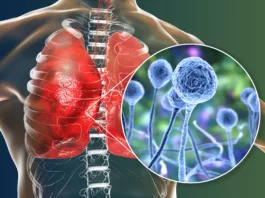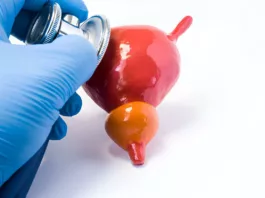Glomerulonephritis is a kidney condition that occurs when the glomeruli—the tiny filtering units within the kidneys—become inflamed due to various causes. Kidneys have many functions, including filtration, regulation of acid-base balance in the body, removal of excess water and waste material, formation of urine, and forming red blood cells by producing erythropoietin. The most essential function of the kidney among these is filtration.
Each kidney contains thousands of glomeruli, which are clusters of capillaries surrounded by a structure known as Bowman’s capsule.These glomeruli contain basement membranes that act as selective filters, allowing only small molecules such as water, electrolytes, and waste products to pass into the urine, while retaining larger molecules like proteins and blood cells in the bloodstream.
When the glomeruli become inflamed—due to infections, autoimmune diseases, immune complex deposition, or other triggers—these filtration barriers can be damaged and can cause glomerular disease. As a result, larger substances such as proteins and red blood cells may leak into the urine, leading to symptoms like hematuria (blood in urine) and proteinuria (protein in urine), potentially impairing overall kidney function.1 Kazi, A. M., & Hashmi, M. F. (2023). Glomerulonephritis. In StatPearls. StatPearls Publishing.
Common Causes of Glomerulonephritis
Infections, autoimmune disorders, and genetic disorders can cause glomerulonephritis. Listed below are some of the causes of this condition.
Alport Syndrome:
It is a genetic disorder in which defective collagen is formed. Due to this defect in collagen formation, the patient suffers from a triad of hearing disability, vision problems, and glomerulonephritis. It is a rare but important cause of glomeruli inflammation. The typical age group is thirties or forties.2Shah, B., First, M. R., Mendoza, N. C., Clyne, D. H., Alexander, J. W., & Weiss, M. A. (1988). Alport’s syndrome: risk of glomerulonephritis induced by anti-glomerular-basement-membrane antibody after renal transplantation. Nephron, 50(1), 34–38. https://doi.org/10.1159/000185113
Autoimmune Disorders:
Autoimmune disorders can also cause glomerulonephritis. An autoimmune disorder is when the body’s immune cells identify any part or cell of the body as foreign or harmful. This triggers a series of immune reactions that damage the body’s organs. This misidentification can also occur in the kidney; therefore, in certain autoimmune disorders, one’s body can attack the kidney’s basement membrane, causing glomerulonephritis.
For instance, Goodpasture’s syndrome is an autoimmune disorder in which the body attacks the basement membranes of both lungs and kidneys, resulting in respiratory and renal symptoms such as breathing difficulty, cough, and typical symptoms of glomerulonephritis.
Lupus nephritis is another autoimmune cause of glomerulonephritis.3. Alexander, M. P., Fervenza, F. C., De Vriese, A. S., Smith, R. J. H., Nasr, S. H., Cornell, L. D., Herrera Hernandez, L. P., Zhang, Y., & Sethi, S. (2016). C3 glomerulonephritis and autoimmune disease: more than a fortuitous association?. Journal of Nephrology, 29(2), 203–209. https://doi.org/10.1007/s40620-015-0218-9
Drugs, Medications & Toxins:
People with poor diet and constant drug usage are also more prone to develop glomerulonephritis. Poor diet, contaminated water, and drugs can damage many body parts and can strongly impact the kidneys. High-dose medications and toxins can also cause this disease. Therefore, a poor diet coupled with the excessive use of drugs, medications, and toxins can strongly impact the kidney, causing inflammation and damaging it, and this might even lead to complete kidney failure or renal disorders.
Skin infections:
In certain skin infections, streptococcus, a form of bacteria, can cause acute glomerulonephritis. Streptococcus infects children from age 2 to 10 once they recover from the illness. Usually, post-infectious glomerulonephritis occurs in children who have recovered from bacterial infections such as impetigo or sore throat. The symptoms of glomerulonephritis start to appear 15 to 20 days after recovery from skin infection or sore throat. Post-streptococcal glomerulonephritis is entirely reversible, and there is no damage to the kidney in the long term.4Iyengar, A., Kamath, N., Radhakrishnan, J., & Estebanez, B. T. (2023). Infection-Related Glomerulonephritis in Children and Adults. Seminars in nephrology, 43(5), 151469. https://doi.org/10.1016/j.semnephrol.2023.151469
Patients with Irregular Blood Pressure & Diabetes:
Chronic hypertension and poorly controlled diabetes are two of the most common contributors to kidney damage worldwide. Over time, they lead to microvascular damage, which can cause or worsen glomerular injury. Diabetic nephropathy, a specific form of glomerular damage, is one of the leading causes of chronic kidney disease and glomerular scarring.
Lung & Gastric cancer:
Certain cancers, including lung and gastric malignancies, can be associated with glomerulonephritis as part of a paraneoplastic syndrome. Though rare, these should be considered, especially in older adults or patients with unexplained glomerular disease.
Other underlying health Issues:
Other underlying health issues such as Hepatitis B and C, multiple Myeloma as well as chronic lymphocytic leukemia can result in kidney damage. These health issues can cause glomerulonephritis and can lead to severe kidney damage or even failure.
Common Types of Glomerulonephritis
Glomerulonephritis can be divided into different types depending on its chronicity and causes. Some common types are listed below:
Post Infectious Glomerulonephritis:
Most common cause of glomerulonephritis is infectious. Usually, it occurs after a child is infected by streptococcus, a type of bacteria. This bacteria causes sore throat or skin infection; ten to fifteen days after initial recovery, the patient may develop glomerulonephritis.
The diagnostic investigations for post-streptococcal infection are the following:
- Urine routine analysis shows red blood cells, RBC casts, and protein in urine.
- ASO titer is diagnostic for PSGN. Increased titer levels show a recent infection in the person.
- Complement levels as C3 levels are low in PSGN.
- Renal function tests show increased creatinine and BUN levels.
- Renal biopsy shows a characteristic hump-like appearance on electron microscopy.
Post-streptococcal glomerulonephritis is a self-resolving disease that requires no definite treatment. However, some patients may need supportive therapy. For edema, the basic medication is diuretics such as furosemide. In case of persistent proteinuria, ACE inhibitors or ARBs are the best choice. In case of infection as a cause of glomerulonephritis, physicians advise appropriate antibiotics depending upon the type of organism.
Children affected by PSGN usually recover within weeks; some may take a couple of months, but recovery is complete, and there is no damage to the kidney.5 Baldwin D. S. (1977). Poststreptococcal glomerulonephritis. A progressive disease?. The American journal of medicine, 62(1), 1–11. https://doi.org/10.1016/0002-9343(77)90344-8
IgA Nephropathy:
It is also known as Berger’s disease. This type slowly progresses over time with intermittent hematuria. During this disease, some patients remain stable with constant care, while in some cases, it leads to chronic kidney disease.6Habas, E., Ali, E., Farfar, K., Errayes, M., Alfitori, J., Habas, E., Ghazouani, H., Akbar, R., Khan, F., Al Dab, A., & Elzouki, A. N. (2022). IgA nephropathy pathogenesis and therapy: Review & updates. Medicine, 101(48), e31219. https://doi.org/10.1097/MD.0000000000031219
Symptoms of Glomerulonephritis
There are a few common symptoms of different types of glomerulonephritis. These symptoms may vary in intensity and severity due to the difference in the causes of Glomerulonephritis. Some of the most common symptoms are as follows:
- Blood in the urine (cola-colored urine)
- Protein in the urine ( foamy urine due to the presence of protein)
- Nausea
- Fatigue
- No appetite
- Rashes on the body
- Swelling of hands and feet
- High Blood pressure
- Fever and abdominal pain
- Fluid retention in the body, resulting in swelling of the face/ankles
- Diarrhea and shortness of breath
- Malaise7Khanna R. (2011). Clinical presentation & management of glomerular diseases: hematuria, nephritic & nephrotic syndrome. Missouri medicine, 108(1), 33–36.
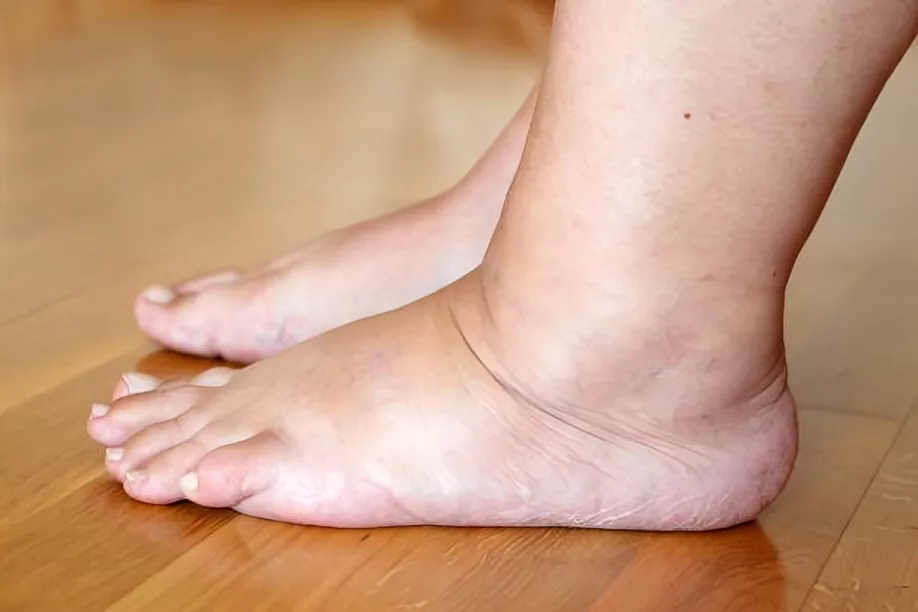
How to diagnose Glomerulonephritis?
The following tests help to diagnose glomerulonephritis:
Urinalysis:
The first and most common physical checkup from your doctor is to understand the symptoms and indicate any kidney problem. After a standard physical check-up, a urinalysis test is conducted. The result of this test helps to identify the presence of protein and red blood cells or any other abnormality in the urine. More protein in urine is diagnostic of glomerulonephritis, while hematuria is an essential symptom of this disease, so proving it through laboratory investigation is equally important.8 Hamadah, A. M., Gharaibeh, K., Mara, K. C., Thompson, K. A., Lieske, J. C., Said, S., Nasr, S. H., & Leung, N. (2018). Urinalysis for the diagnosis of glomerulonephritis: role of dysmorphic red blood cells. Nephrology, dialysis, transplantation : official publication of the European Dialysis and Transplant Association – European Renal Association, 33(8), 1397–1403. https://doi.org/10.1093/ndt/gfx274
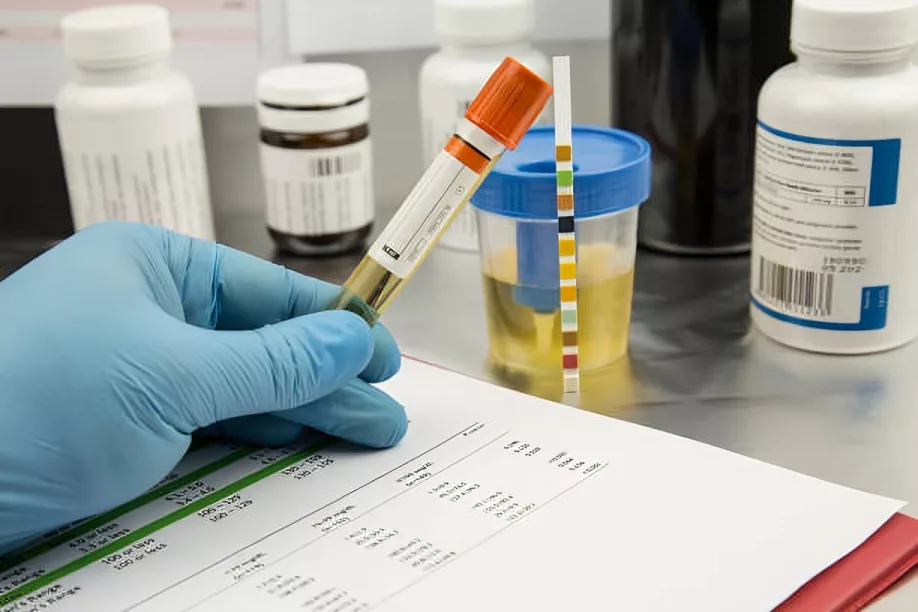
Blood tests:
Blood tests can also help diagnose glomerulonephritis. The blood test includes a complete blood picture of the serum urea, creatinine, and protein levels.
X-Ray & CT Scan:
Other tests to diagnose glomerulonephritis are radiological images. Radiological examination is not a routine requirement in diagnosing acute glomerulonephritis. Still, in complex cases where the clinician may not be able to analyze the primary cause, doctors may suggest X-rays and CT Scans if needed. These tests help examine and understand the size and shape of the kidney or any damage to the kidney, which helps in understanding and identifying the cause and prognostic factors of glomerulonephritis in complex cases.
Kidney Biopsy:
After these initial checkups, the doctor explicitly suggests renal biopsy. Sometimes, blood and urine tests cannot identify the inflammation, genetic issues, or protein deposits. For this reason, a kidney biopsy is necessary to explore and identify the development of glomerulonephritis in the kidney.9 Schnuelle P. (2023). Renal Biopsy for Diagnosis in Kidney Disease: Indication, Technique, and Safety. Journal of clinical medicine, 12(19), 6424. https://doi.org/10.3390/jcm12196424
Management & Treatment plan for Glomerulonephritis
The treatment of glomerulonephritis varies according to its causes, including changes in diet and different types of medication. Severe cases may require dialysis.
Dietary Changes:
It is better to avoid diets rich in protein, as they can strain your kidneys and may cause further damage to your renal membranes. Some significant dietary changes that doctors advise are as follows,
- Less salt intake, including sodium and potassium, as salt, can further damage your kidneys.
- Processed and fast food must be avoided.
- Protein intake is reduced as more protein in the diet can strain the kidneys significantly.
- Salted Nuts and pickles are restricted.
- Excessive phosphorus in the food can result in increasing kidney issues.
- Several foods like red meat should also increase inflammation and be avoided.
- If the swelling in the kidney remains, patients may be advised to reduce water or liquid intake.10Schaap, G. H., Bilo, H. J., van der Meulen, J., Oe, P. L., & Donker, A. J. (1993). Effect of changes in daily protein intake on renal function in chronic renal insufficiency: differences in reaction according to disease entity. Nephron, 64(2), 207–215. https://doi.org/10.1159/000187316
Steroids:
Steroids help to reduce inflammation of the basement membranes of the kidney. It also helps in autoimmune types of glomerulonephritis.
Antibiotics:
Antibiotics help to treat post-streptococcal and other types of glomerulonephritis when the cause is any infection. The usual period for taking the antibiotics is 14 days.
Immunosuppressants:
In autoimmune causes of glomerulonephritis, immunosuppressants are a great choice. These medications help decrease the body’s immunity, which in turn weakens the body’s attack on its healthy tissues. As a result, the body does not attack its parts, including the kidney.
Diuretics:
Facial swelling, pedal edema, pulmonary edema, and ascites all can occur in patients suffering from acute glomerulonephritis. It happens because of the retention of fluid in the body. It is treated by adding diuretics such as furosemide so that more urine is formed and excess liquid is removed from the body.11 Pruitt, A. W., & Boles, A. (1976). Diuretic effect of furosemide in acute glomerulonephritis. The Journal of pediatrics, 89(2), 306–309. https://doi.org/10.1016/s0022-3476(76)80475-1
Dialysis & Kidney Transplant:
The dialysis treatment is helpful for the patient when the disease is severely impacting him. Some patients also need to go for a kidney transplant. However, patients with chronic stage of glomerulonephritis should consider a kidney transplant if it has not been treated and diagnosed at earlier stages. In such cases, glomerulonephritis results in damaging the kidney severely, leading to complete kidney failure. At this point, medication can no longer reverse the issue, and doctors believe that the most effective solution in such cases is a kidney transplant.12Glassock R. J. (2021). Precision medicine for the treatment of glomerulonephritis: a bold goal but not yet a transformative achievement. Clinical kidney journal, 15(4), 657–662. https://doi.org/10.1093/ckj/sfab270
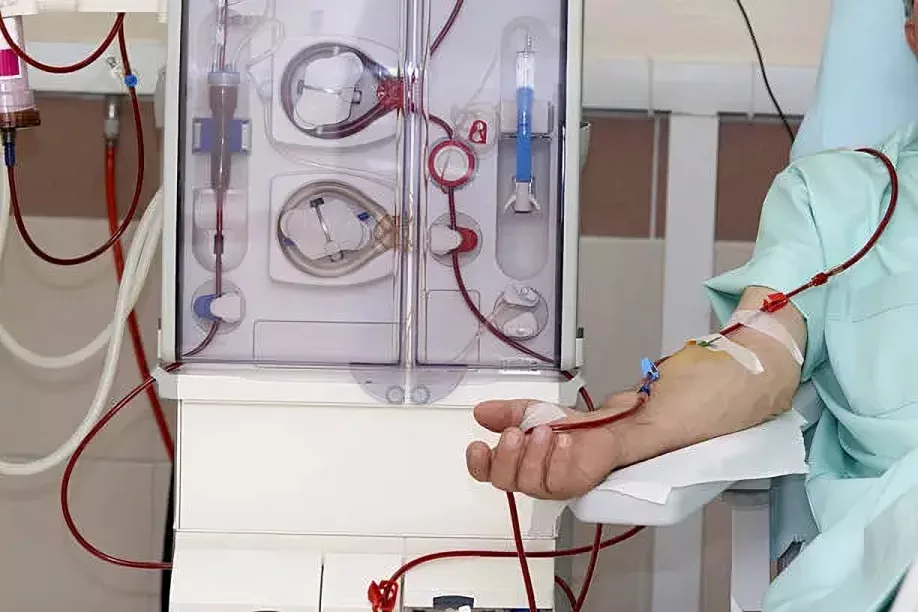
Acute & Chronic Glomerulonephritis
Acute nephritis shows sudden development and progress of the disease. However, chronic glomerulonephritis takes time to progress and develops with time. Acute glomerulonephritis recovers without any permanent damage to the kidney within weeks or months. In chronic glomerulonephritis, it can lead to chronic kidney disease or, in the worst case, end-stage renal disease.
Glomerulonephritis and Nephritic Syndrome
Glomerulonephritis commonly presents as nephritic syndrome, a clinical condition characterized by hematuria (blood in the urine), mild to moderate proteinuria, hypertension, and decreased kidney function. The underlying inflammation of the glomeruli damages the capillary walls, allowing red blood cells and proteins to pass into the urine—features that define nephritic syndrome.
This syndrome represents the body’s response to glomerular injury, and it reflects the severity and extent of inflammation. Patients may experience swelling, reduced urine output, and elevated blood pressure, depending on the cause and progression of the disease.
Glomerulonephritis Vs. Nephrotic Syndrome
Glomerulonephritis is usually associated with inflammation of the glomeruli, while in Nephrotic syndrome, glomerular barriers are damaged. Several diagnostic features, such as a large amount of protein in the urine (more than 3.5 grams/day), usually characterize nephrotic syndrome. A mild to moderate amount of protein in urine is present in glomerulonephritis. It is characterized by urine red blood cells that are absent in nephrotic syndrome. These diseases differ in their types and causes; however, both are kidney-related.13Madaio, M. P., & Harrington, J. T. (2001). The diagnosis of glomerular diseases: acute glomerulonephritis and the nephrotic syndrome. Archives of internal medicine, 161(1), 25–34. https://doi.org/10.1001/archinte.161.1.25
Conclusion
The kidney plays a key role in regulating your body’s excessive waste, water, and blood. People who have diabetes, high blood pressure, and other common health issues need to regulate them to avoid any damage to the kidney that can potentially lead to kidney failure. A proper healthy diet, exercise, and yearly checkups can help reduce the risk of kidney-related diseases. It can also help identify diseases in earlier stages if they occur. Glomerulonephritis can completely recover with proper treatment, medication, and dietary changes.
If chronic Glomerulonephritis is diagnosed, it is essential to explore the underlying cause to thoroughly understand the root cause and prescribe the treatment plan accordingly. Kidney transplant may be prescribed to patients if the disease has already damaged the kidney. Acute Glomerulonephritis may recover independently, or patients might need few medications. Following the doctor’s advice to treat Glomerulonephritis is essential to avoid any long-term damage.
Refrences
- 1Kazi, A. M., & Hashmi, M. F. (2023). Glomerulonephritis. In StatPearls. StatPearls Publishing.
- 2Shah, B., First, M. R., Mendoza, N. C., Clyne, D. H., Alexander, J. W., & Weiss, M. A. (1988). Alport’s syndrome: risk of glomerulonephritis induced by anti-glomerular-basement-membrane antibody after renal transplantation. Nephron, 50(1), 34–38. https://doi.org/10.1159/000185113
- 3. Alexander, M. P., Fervenza, F. C., De Vriese, A. S., Smith, R. J. H., Nasr, S. H., Cornell, L. D., Herrera Hernandez, L. P., Zhang, Y., & Sethi, S. (2016). C3 glomerulonephritis and autoimmune disease: more than a fortuitous association?. Journal of Nephrology, 29(2), 203–209. https://doi.org/10.1007/s40620-015-0218-9
- 4Iyengar, A., Kamath, N., Radhakrishnan, J., & Estebanez, B. T. (2023). Infection-Related Glomerulonephritis in Children and Adults. Seminars in nephrology, 43(5), 151469. https://doi.org/10.1016/j.semnephrol.2023.151469
- 5Baldwin D. S. (1977). Poststreptococcal glomerulonephritis. A progressive disease?. The American journal of medicine, 62(1), 1–11. https://doi.org/10.1016/0002-9343(77)90344-8
- 6Habas, E., Ali, E., Farfar, K., Errayes, M., Alfitori, J., Habas, E., Ghazouani, H., Akbar, R., Khan, F., Al Dab, A., & Elzouki, A. N. (2022). IgA nephropathy pathogenesis and therapy: Review & updates. Medicine, 101(48), e31219. https://doi.org/10.1097/MD.0000000000031219
- 7Khanna R. (2011). Clinical presentation & management of glomerular diseases: hematuria, nephritic & nephrotic syndrome. Missouri medicine, 108(1), 33–36.
- 8Hamadah, A. M., Gharaibeh, K., Mara, K. C., Thompson, K. A., Lieske, J. C., Said, S., Nasr, S. H., & Leung, N. (2018). Urinalysis for the diagnosis of glomerulonephritis: role of dysmorphic red blood cells. Nephrology, dialysis, transplantation : official publication of the European Dialysis and Transplant Association – European Renal Association, 33(8), 1397–1403. https://doi.org/10.1093/ndt/gfx274
- 9Schnuelle P. (2023). Renal Biopsy for Diagnosis in Kidney Disease: Indication, Technique, and Safety. Journal of clinical medicine, 12(19), 6424. https://doi.org/10.3390/jcm12196424
- 10Schaap, G. H., Bilo, H. J., van der Meulen, J., Oe, P. L., & Donker, A. J. (1993). Effect of changes in daily protein intake on renal function in chronic renal insufficiency: differences in reaction according to disease entity. Nephron, 64(2), 207–215. https://doi.org/10.1159/000187316
- 11Pruitt, A. W., & Boles, A. (1976). Diuretic effect of furosemide in acute glomerulonephritis. The Journal of pediatrics, 89(2), 306–309. https://doi.org/10.1016/s0022-3476(76)80475-1
- 12Glassock R. J. (2021). Precision medicine for the treatment of glomerulonephritis: a bold goal but not yet a transformative achievement. Clinical kidney journal, 15(4), 657–662. https://doi.org/10.1093/ckj/sfab270
- 13Madaio, M. P., & Harrington, J. T. (2001). The diagnosis of glomerular diseases: acute glomerulonephritis and the nephrotic syndrome. Archives of internal medicine, 161(1), 25–34. https://doi.org/10.1001/archinte.161.1.25


